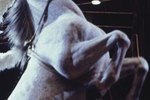Things You'll Need
Telfa pads
Rolled cotton
Rolled gauze
Porous tape
When a dog sustains an injury to an ear, the wound may bleed profusely. In addition, the irritation caused by the injury may cause some dogs to shake their head excessively, encouraging further bleeding and splattering blood over a wide area. When these types of ear injuries occur, bandaging or wrapping the ears may become necessary.
In addition, if your dog has had any type of surgical procedure performed on the ears, it may be necessary to wrap the ears to protect the surgical wounds.
Fold both ears back so that they are flat against the top of the dog's head. Place telfa pads between the surface of the ears and the top of the head. If the ears are long enough to overlap, place telfa pads between the surfaces of the ears. Telfa pads should also be placed over any wounds on the ears.
Wrap the rolled cotton around the head to provide cushioning for the bandage and help avoid winding the bandage too tightly.
Wrap the rolled gauze loosely around the head over the top of the rolled cotton. Do not pull the gauze tight enough to cause pressure on the vocal cords (voice box) or trachea (windpipe).
Use the porous tape to cover the surface of the bandage. Extend the tape in front of the bandage to anchor the bandage to the skin and keep the bandage from sliding backward.
Tips
Make sure your dog is calm before attempting to bandage the ears. Do not try to bandage wounds for dogs who are extremely agitated or acting aggressively. A washcloth and warm water can be used to clean any excess blood from the head and ears before placing the bandage, if necessary. If only one ear is injured, it is acceptable to bandage the wounded ear and leave the healthy ear free by creating an opening in the bandage large enough for the unwounded ear.
Warnings
Veterinary care should be sought for wounds that are bleeding, are not healing properly, have a foul-smelling discharge or are painful for the dog. When removing the bandage, use a pair of scissors to cut across the width of the bandage under the neck. Once cut, the bandage should lift off of the head and ears easily. Do not cut across the top of the head to avoid accidentally cutting the ears.
Writer Bio
Lorie Huston began writing in 2001 and is currently the Pet Care Feature Writer at Suite101.com and the National Pet Health Examiner at Examiner.com. She is a practicing veterinarian. She holds a Doctor of Veterinary Medicine from Iowa State University and a Bachelor of Science degree from the University of Nebraska.





